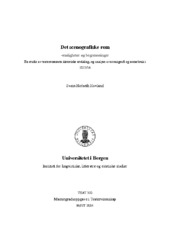Det scenografiske rom, -muligheter og begrensninger. En studie av teaterrommets historiske utvikling, og analyse av scenografi og scenebruk i 2013/14
Master thesis
Permanent lenke
https://hdl.handle.net/1956/9188Utgivelsesdato
2014-11-20Metadata
Vis full innførselSamlinger
Sammendrag
En teaterforestilling må finne sted i et rom. Denne oppgaven tar for seg de muligheter og begrensninger som gis av dette rommet. Oppgavens første del skisserer det jeg anser som de fem viktigste «skiftene» i utviklingen av scenografi og teaterrommets utforming på 1900-tallet. Her diskuteres bidrag fra sentrale teaterteoretikere og -praktikere som Craig, Appia, Schlemmer, Piscator, Gropius, Brecht, Svoboda, Grotowski, Kantor, Lepage og Wilson. Andre del legger frem komparative scenografiske analyser av tolv forestillinger satt opp ved større norske teaterhus i 2013/14, og knytter disse opp mot mulige inspirasjonskilder i historien. Min analyse viser at de fleste forestillingene lar seg inspirere av idéer fra 1960-tallet om en ikke-illusjonistisk og sparsom scenografi som retter fokuset mot en fysisk spillestil. Så å si ingen av stykkene lar seg inspirere av vektleggingen på 1920- tallet av et teknologisk avansert teaterrom som kunne inkludere tilskueren i det scenografiske rom. Inndelingen av teaterrommet mellom skuespiller og tilskuer, slik en ser det i barokksceneformen, er ofte reprodusert i de arkitektonisk sett helhetlige teaterrommene som vokste i popularitet på 60-tallet. Analysene kan peke i retning av en mulig tendens hvor stiliserte, anvendelige scenografier med et begrenset behov for teknisk avansert scenemaskineri er det som forekommer oftest og er den foretrukne scenografiske trenden i Norge i 2013/14. A theatre play requires a space - a room, whether indoors or outdoors - in which to be performed. This thesis examines the possibilities and limitations given by this space. Part One of the thesis outlines what I consider to be the five crucial shifts" in the development of 20th century scenography and (arrangement of) the theatre room. This includes discussions of the contribution of central theoreticians and practitioners in the theatre, such as Craig, Appia, Schlemmer, Piscator, Gropius, Brecht, Svoboda, Grotowski, Kantor, Lepage and Wilson. In the second part of the thesis, comparative analyses are presented of scenography from twelve plays performed at major Norwegian theatres during 2013/14, linking these to possible historical sources of inspiration. My analysis shows that most of the plays seem to be inspired by an emphasis on non-illusionistic and sparse scenography, typical of the 1960s, which focused on a physical acting style. Hardly any of the plays show signs of inspiration from the emphasis in the 1920s on a technologically advanced theatre room, which could include the spectator in the scenographical room". In the productions that are analysed, the division of the theatre room between actors and audience, as is inherent in the architecture of the baroque stage, is often replicated in the architecturally unified theatre rooms made popular in the 60s. The analysis suggests a possible tendency in which simplified scenography, accessible to several levels of fiction, with a limited need for technically advanced machinery, is the most common and preferred scenography trend in Norway in 2013/14.
